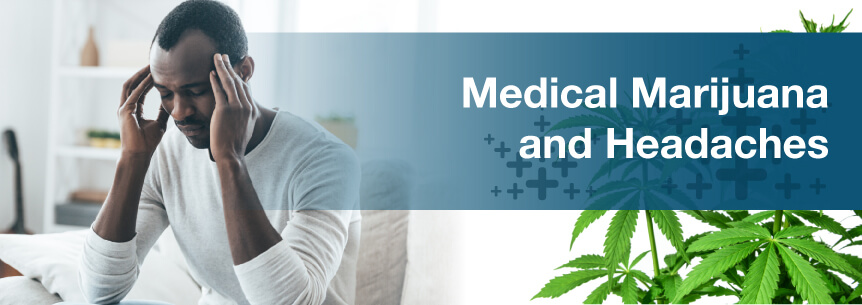
Most of us suffer from headaches now and then. But some headaches can be so chronic and debilitating they affect your ability to perform daily tasks or go to work. When living with these aches, you may be desperate to find an effective treatment when over-the-counter medications aren’t working for you. Studies are now showing medical marijuana for headaches may just be one of those treatments.
Many individuals are familiar with the uncomfortable, distracting and throbbing pain of headaches. Nearly everyone gets a headache now and then. By the age of 15, almost two out of three children will get a headache. More than nine in 10 adults will get a headache at some point in their lives. It’s the most common type of pain, and one of the leading causes of missing school or work. When you leave chronic headaches untreated, they can get so severe they interfere with your day-to-day activities.
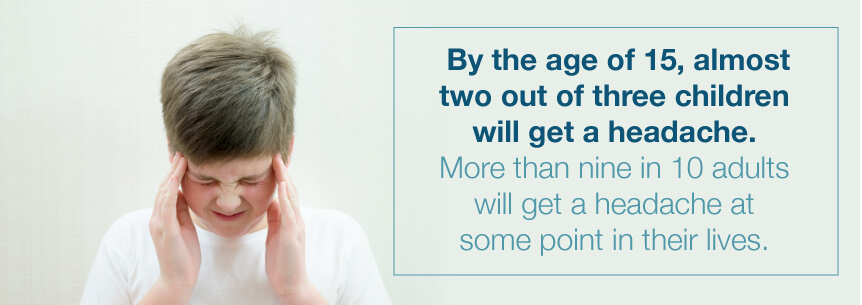
Some headache types run in families. You may have vanishing headache episodes, only to experience a recurrence later in life. You can even have more than one headache type simultaneously.
Common triggers of certain headaches include:
There are more than 150 types of headaches, including the following:
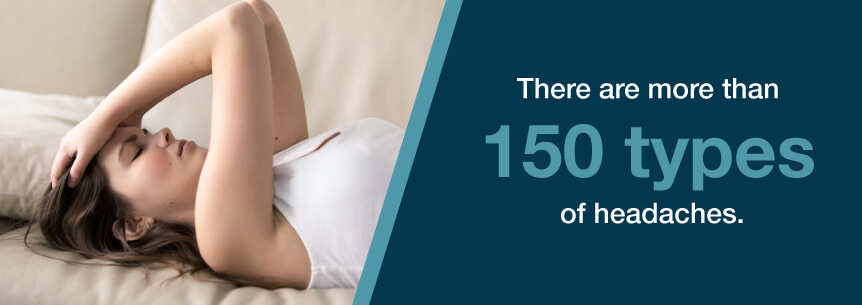
Caffeine Headaches
Caffeine affects your brain’s blood flow. Too much caffeine can cause a headache. At the same time, abruptly stopping caffeine use can also cause headaches.
Cluster Headaches
Cluster headaches cause chronic misery where you experience a piercing, burning or throbbing pain around or behind one eye.
Exertion Headaches
This type of headache occurs rapidly after you’ve engaged in intense physical activity. Running, weightlifting and even sexual intercourse can trigger an exertion headache.
Hormone Headaches
Women may get these headaches due to hormone level changes during their pregnancy, period or menopause. Birth control pills may also trigger hormone headaches.
Hypertension Headaches
You can get a headache from high blood pressure, signaling an emergency. Hypertension headaches come on when your blood pressure rises to dangerously high levels. Your headache may pulsate and is generally on both sides of your head. Activity of any kind can make these headaches worse.
Migraine Headaches
Migraines are intense headaches generating throbbing, pounding pain. A migraine can last anywhere from a few hours to a few days, and may come on several times a month. In addition to the pain, you may experience other symptoms with migraines, like sensitivity to noise, light or smells, loss of appetite, nausea or vomiting, belly pain and upset stomach.
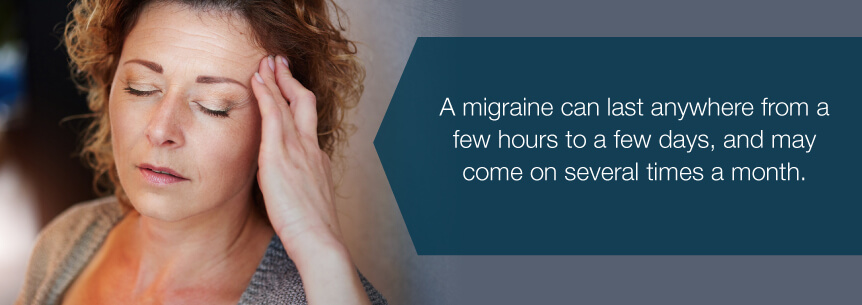
Post-Traumatic Headaches
These headaches may develop after you’ve had a head injury. They feel like tension or migraine headaches, may become chronic and last anywhere from six months to a year after your injury.
Rebound Headaches
Rebound headaches come on from overusing medication. They may feel like a dull tension headache or a painful migraine. Overusing OTC pain relievers can make you more susceptible to rebound headaches.
Sinus Headaches
Inflamed sinuses lead to a constant and deep pain in your forehead, cheekbones and bridge of your nose.
Tension Headaches
Tension headaches are most common in teens and adults. They can come and go, cause mild to moderate pain and produce no other symptoms.
Headaches have been around as long as humanity has. Due to their disabling effects and prevalence, headaches preoccupied the beliefs and emotions of ancient civilizations. Because of this, authors have been trying to figure out and classify the various types of headaches from the beginning of medicine.
Papyrus manuscripts found buried with a mummy in Thebes, as well as some surviving Babylonian writings describing migraines, date as far back as 3000 BCE. Both these cases detail accounts that are surprisingly close to the experiences today’s migraine sufferers have.
As you’ve read, there are various headache types, and even though not all headaches are the same, they all cause pain, some leading to chronic pain. Other types of headaches, however, create other undesirable symptoms like:
While having a headache usually isn’t a symptom of a life-threatening condition, if you get headaches following a trauma to the head, you should give your physician a call right away. You’ll also want to contact your physician if you’re experiencing any of these symptoms along with your headaches:
You’ll also need your doctor to evaluate you if you have a yellowish-green nasal discharge and pressure around your eyes, which could indicate a sinus infection.
Effects of headaches and migraines, according to the International Headache Society, include:
Migralepsy is a condition where a migraine triggers an epileptic seizure. You’ll likely get a migraine first, then the seizure around an hour or so after. It’s a rare condition.
This condition links your migraine to a stroke. You’ll have a migraine headache with an aura lasting over an hour. The aura, in some cases, continues even after your headache goes away. Auras lasting more than an hour may suggest you have a brain bleed, and therefore, you’ll want to see your physician immediately.
Individuals with migraines have around two times the risk of stroke, according to England’s National Health Service. Women who get migraines and also take oral contraceptives are also more susceptible to stroke.
If you’re suffering from daily, chronic headaches, you’re at a greater risk of experiencing sleep disturbances, anxiety, depression and other physical and psychological problems.
You may also experience episodic syndromes with migraines, such as sleepwalking, teeth grinding, motion sickness and night terrors. Migraines can also lead to cyclical vomiting, vertigo and abdominal pain.
The Statistics Portal reports the following headache and migraine facts:
The Migraine Research Foundation reports the following about migraines:
Several factors will determine the type of treatment for your headaches. These factors include the frequency and type of headaches you have, and what is causing them. Your doctor will tailor your treatment specifically to your needs.
Medications like ibuprofen, acetaminophen and aspirin can help with mild headaches. There are migraine medications combining aspirin, acetaminophen and caffeine to help with migraine headaches. These medicines, however, may not be effective if you’re struggling with severe migraine headaches.
If you take these medications too often or for an extended time, they can result in gastrointestinal bleeding, ulcers, liver problems and medication-overuse headaches.
These relieve migraine headache pain and other symptoms effectively. They constrict your blood vessels and block your brain’s pain pathways. Side effects of triptans may include:
If you’re at risk of heart attacks or stroke, your physician may advise you to refrain the use of triptans.
Counseling includes services like group therapy, one-on-one therapy or support groups designed to assist you in identifying triggers of your headaches and teach you coping strategies.
Headache education includes figuring out what triggers your headaches. Common headache triggers include:
Being educated on these types of things can help you avoid your headache triggers.
Manage your stress with relaxation techniques like progressive muscle relaxation, deep breathing exercises, music relaxation or mental imagery relaxation.
More than three decades ago, researchers found out marijuana’s bioactive ingredients mimicked your body’s endocannabinoids. These neuro-chemicals control your brain receptors responsible for balancing inflammation and pain.
Doctors have successfully indicated both non-photoactive and psychoactive types of cannabis-based medications for just about every kind of headache.
The idea of using marijuana for headaches isn’t new. Cannabis wasn’t illegal in the U.S. until the Marihuana Tax Act of 1937. Before that, patients used the herb to treat headaches of many types. Doctors commonly prescribed marijuana to treat these ailments.
Earlier findings noted in a study suggest an endocannabinoid system dysfunction or deficit in endocannabinoids may link to the development of migraines and other types of headaches. Your endocannabinoid system regulates different functions like sleep, mood, immune system function and pain response. Cannabidiol (CBD), tetrahydrocannabinol (THC) and other cannabinoids found in medical weed interact with your endocannabinoid system’s receptors, especially the CB1 receptor, to hinder the inflammation leading to headache pain.
Medical cannabis for headaches helps by:
It can also help with some of the other headache symptoms mentioned above, including:
If you’re suffering from headaches — regardless of whether they’re simple tension headaches, or more severe headaches like migraines — marijuana can be an effective remedy.
As you’ve probably figured out by now, medical pot is a highly effective headache treatment. However, there are specific strains of medical marijuana for headaches that may work better than others for treating your headache pain and other symptoms. Below are some of the best strains to use for headaches.
When suffering from headaches, no matter how severe, you can find relief with the strains above. However, there are many other options available to you for headache relief. Many already know these strains effectively treat headaches and are a good place to start.
You can separate cannabis and headaches consumption methods into three main categories:
You can use other methods to take medical marijuana as well.
Oral THC administration reduces both experimentally induced and chronic pain, according to studies.
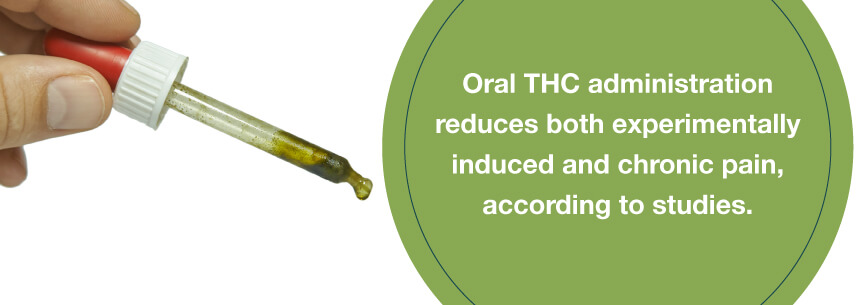
Oral consumption methods are those where you administer marijuana through your mouth. Some examples include:
Inhalation techniques appear to offer fast effects and eliminate migraine headaches almost immediately.
Examples of inhalation methods include:
Topicals are absorbed through the skin and may include:
Today, more consumption methods are coming out all the time for medical marijuana to benefit patients’ varying needs for getting medical pot into their systems.
You don’t have to suffer from chronic headaches any longer. As more states legalize medical cannabis, you’ll find an increasing number of dispensaries opening up to fulfill your needs. However, with so many dispensaries to choose from, you’ll need to know which is the best place to get your medical marijuana. Thankfully, you can search for a medical marijuana dispensary or connect with a doctor all in one place with the support you need to make the right choice.
Find A Doctor Find A Dispensary